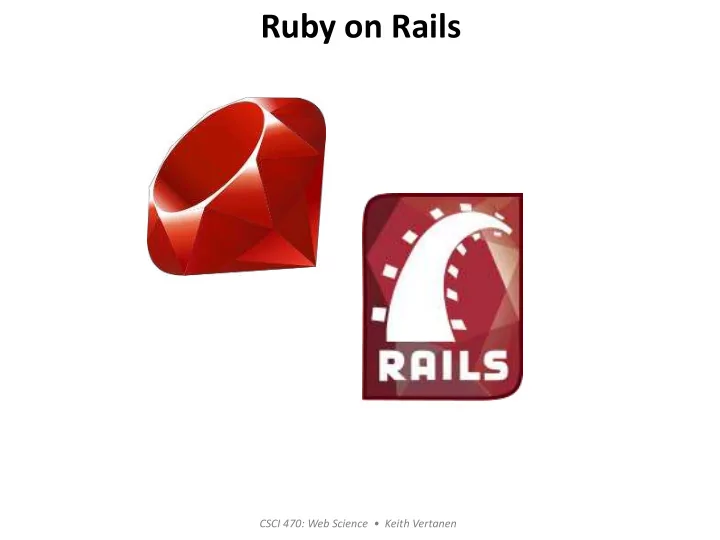

Ruby on Rails CSCI 470: Web Science • Keith Vertanen
Overview • Ruby programming language – History and philosophy – Features – Syntax • Ruby on Rails – History and philosophy – Rails architecture – Directory structure 2
Ruby: History & philosophy • History – 1993, Yukihiro Matsumoto – General purpose language • Best known for web programming "I was talking with my colleague about the possibility of an object-oriented scripting language. I knew Perl (Perl4, not Perl5), but I didn't like it really, because it had the smell of a toy language (it still has). The object-oriented language seemed very promising. I knew Python then. But I didn't like it, because I didn't think it was a true object-oriented language — OO features appeared to be add- on to the language. As a language maniac and OO fan for 15 years, I really wanted a genuine object- oriented, easy-to-use scripting language. I looked for but couldn't find one. So I decided to make it." – Yukihiro Matsumoto "Often people, especially computer engineers, focus on the machines. They think, 'By doing this, the machine will run faster. By doing this, the machine will run more effectively. By doing this, the machine will something something something.' They are focusing on machines. But in fact we need to focus on humans, on how humans care about doing programming or operating the application of the machines. We are the masters. They are the slaves." – Yukihiro Matsumoto 3
Ruby: features • Interpreted: Matz's Ruby Interpreter (MRI) – 1.9+, Yet Another Ruby Virtual Machine (YARV) • Automatically compiles to byte-code, no separate tool • Also other byte-code compilers, e.g. Rubinius • Dynamic and strongly typed – Var type determined at runtime, type can change • But strict about what you can do with types Perl: print "5" + 3 → 8 Javascript: alert("5" + 3) → "53" Ruby: puts "5" + 3 → runtime error puts "5".to_i + 3 → 8 – Uppercase variable name = constant 4
- Ruby: features • Object-oriented – Everything is an object 199.abs 5.times { print "Hello world! " } – Single inheritance • But mixins allow shared methods – Duck typing: if it walks like a duck, talks like a duck, then treat it like a duck def plus_one_to_y ( x ) @y = x + 1 • Everything is an expression # puts "blah" end • RubyGems puts plus_one_to_y(10) – Gem provides a library or plug-in puts @y – Package manager like apt-get – "There's a gem for that" 5
Collections a = [1, 'hi' , 3.14, 1, 2, [4, 5]] a [2] # => 3.14 a .[](2) # => 3.14 a .reverse # => [[4, 5], 2, 1, 3.14, 'hi', 1] a .flatten.uniq # => [1, 'hi', 3.14, 2, 4, 5] hash = { :water => 'wet' , :fire => 'hot' } puts hash [ :fire ] # prints "hot" hash .each_pair do | key , value | # or: hash.each do |key, value| puts " #{ key } is #{ value } " end # returns { :water => "wet" , :fire => "hot" } and prints: # water is wet # fire is hot # deletes the pair :water => 'wet' and returns "wet" hash .delete :water # deletes the pair :fire => 'hot' and returns {} hash .delete_if {| key ,value| value == 'hot' }
Classes, constructors, instance vars class Sample def hello puts "Hello Ruby!" end end object = Sample . new object .hello class Person def initialize name @name = name end def get_name @name end end person = Person .new "Jane" puts person .get_name
Getters and setters class Person attr_reader :name # Create getter attr_accessor :age # Create getter and setter def initialize ( name , age ) @name , @age = name , age end def to_s " #{name} ( #{age} )" end end bob = Person .new( "Bob" , 33) puts(bob.name) # Prints "Bob" puts(bob.age) # Prints 33 bob.age = 30 # Changes age to 30 bob.name = "Alice" # Runtime exception
OOP: inheritance class Being @@count = 0 def initialize @@count += 1 end def show_count "There are #{ @@count } beings" end end class Animal < Being def initialize super puts "Animal is created" end end class Dog < Animal def initialize super puts "Dog is created" end end
Duck typing class Duck def quack 'Quack!' end def swim 'Paddle paddle paddle...' end end class Goose def honk 'Honk!' end def swim 'Splash splash splash...' end end def make_it_swim ( duck ) duck .swim end puts make_it_swim( Duck .new) puts make_it_swim( Goose .new)
Modules and mixins module A def a1 puts "a1 is the best!" end end module B def b1 puts "seriously, what about me: b1?!?" end end class Sample include A include B def s1 puts "s1 is king of the hill!" end end samp = Sample .new samp .a1 samp .b1 samp .s1
Ruby on Rails • History – 2005, David Heinemeier Hansson • Working on Basecamp project management tool • Extracted Rails from the project • Philosophy: – Convention over configuration – Don't Repeat Yourself (DRY) – Rails is opinionated • Makes assumptions about the "best" way to do things • Designed to encourage you to do it that way 12
Rails architecture • Model View Controller – Model • Article class: a blog entry • Table articles in a database • Ruby file: app/models/article.rb – View • Handles presentation to the user http://betterexplained.com/articles/intermediate-rails- understanding-models-views-and-controllers/ • Template: app/views/articles/show.html.erb • The controller's minions – Controller • Parses user requests, queries/updates models • Ruby file: app/controllers/articles_controller.rb 13
Getting started: Rails tutorial http://railsforzombies.org/ 14
Ruby on Rails • Ruby: the programming language – Object-oriented scripting language – Dynamic and strongly typed – Strong developer community – "There's a gem for that" • Ruby on Rails: web framework – Convention over configuration – Don't Repeat Yourself (DRY) – Model-View-Controller design pattern 15
Recommend
More recommend